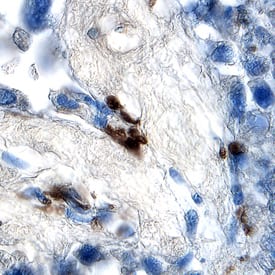Human Smad2 Antibody
R&D Systems, part of Bio-Techne | Catalog # AF4037

Key Product Details
Species Reactivity
Applications
Label
Antibody Source
Product Specifications
Immunogen
Lys20-Thr108
Accession # Q15796
Specificity
Clonality
Host
Isotype
Scientific Data Images for Human Smad2 Antibody
Smad2 in Human Pancreatic Cancer Tissue.
Smad2 was detected in immersion fixed paraffin-embedded sections of human pancreatic cancer tissue using Goat Anti-Human Smad2 Antigen Affinity-purified Polyclonal Antibody (Catalog # AF4037) at 5 µg/mL overnight at 4 °C. Tissue was stained using the Anti-Goat HRP-DAB Cell & Tissue Staining Kit (brown; Catalog # CTS008) and counterstained with hematoxylin (blue). Specific staining was localized to nuclei. View our protocol for Chromogenic IHC Staining of Paraffin-embedded Tissue Sections.Applications for Human Smad2 Antibody
Immunohistochemistry
Sample: Immersion fixed paraffin-embedded sections of human pancreatic cancer tissue
Formulation, Preparation, and Storage
Purification
Reconstitution
Formulation
Shipping
Stability & Storage
- 12 months from date of receipt, -20 to -70 °C as supplied.
- 1 month, 2 to 8 °C under sterile conditions after reconstitution.
- 6 months, -20 to -70 °C under sterile conditions after reconstitution.
Background: Smad2
SMAD2 (Sma and MAD-related protein 2; also MAD2, MADR2 and MADH2) is a 58-62 kDa member of the dwarfin/SMAD family of proteins. It is widely expressed, particularly in striated muscle, and exists constitutively in the cytoplasm. SMAD2 is a downstream mediator of TGF-beta and activin signaling. In particular, SMAD2 is a nonphosphorylated monomer in unstimulated cells. Upon ALK-4, -5, and -7 receptor activation, SMAD2 is phosphorylated and forms either homotrimers or heterotrimers with SMAD3 and SMAD4. These heterotrimers enter the nucleus and initiate gene transcription. Human SMAD2 is 467 amino acids (aa) in length. It contains one regulatory MH domain (aa 120-176) and a transactivation MH domain (aa 274-467). There are at least five utilized phosphorylation sites and one acetylation site at Lys19 that promotes transcriptional activity. There are four potential isoform variants. One shows a deletion of aa 79-108, while another contains the same deletion coupled to another deletion of aa 219-243. A third shows a deletion of aa 344-358, and a fourth is missing aa 221-225. Over aa 20-108, human SMAD2 shares 98% aa identity with mouse SMAD2.
Long Name
Alternate Names
Gene Symbol
UniProt
Additional Smad2 Products
Product Documents for Human Smad2 Antibody
Product Specific Notices for Human Smad2 Antibody
For research use only
